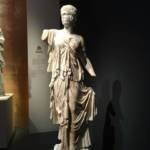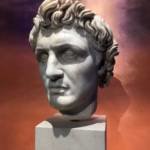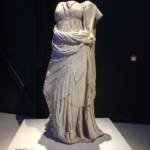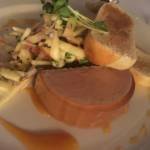The Pergamon Museum in Berlin and the artist Yadegar Asisi have once again partnered for a Panorama 360º. The museum has been partially closed due to extensive renovations for several years, thus making the Pergamon Altar and its archeological treasures inaccessible to visitors. Not only is the new installation a chance to see some of the sculptures once again, but also to apprehend them in an exciting and compelling environment.
The Exhibit
The Antique Sculptures
Stepping into the exhibition, the visitor discovers another world. There, the marble sculptures that welcome us are strikingly beautiful ; delicate lighting enhances every exquisite detail. Large sculptures in the round—most of them presented at our level—populate several rooms. The changing light plays in the folds of the peploi and the curls of hair and beards. The subtle changes copy the passing of time, letting the shadows grow and fade on the white stone. Despite being made of marble, the women in the first room seem light and ready to move. Will the Pergamon Dancer start swaying and twirling across the room, in front of our eyes?
Athena and Hera
Farther, the dignified statue of Athena looks down on us, calm yet all-powerful. She is both splendid and frightening. The cloth of her tunic is exquisitely detailed and it falls elegantly to her feet. A brooch with the head of Medusa adorns her peplos, yet it isn’t just jewelry, it symbolizes the goddess’ wrath and cruelty. A reminder not displease her! Facing her, the gorgeous statue of Hera is solemn and welcoming. Her tunic is of a different style, perhaps more distinguished than Athena’s. These statues are large and stand on pedestals. They tower over us, mere humans. The gold background accentuates their divine nature. Even today, viewers are in awe. Amazed, they wonder at the power and beauty of the Greek gods.

Telephos’ Frieze
The curators of the exhibition reserved a special place to the Telephos Frieze. Visitors step into the upper room of the altar through pillars. The preserved relief panels presented here tell the story and adventures of Telephos, the hero who founded Pergamon. After fully enjoying the sculptures, take a moment and have a seat on the bench to enjoy the sunrise and sunset imagined by Asisi. How did Ancient Greek perceive this moment? Was it contemplative? Were they busy preparing for the next sacrifice and hurrying to finish assembling the objects necessary to the ceremony?

The Panorama Itself
The Structure
The large cylinder, built especially for the Pergamon Panorama, is a window into the life of the Greek inhabitants of this city, under the reign of Emperor Hadrian. After months of research, drawings and photography, Asisi and his team created extremely detailed images using the most modern technologies.
Visitors can discover the image from the ground and climb up the scaffolding to have a different viewpoint. In the cylinder as well, light and sound indicate the passing of time, setting an atmosphere that powerfully surrounds modern visitors.
The Canvas
At first, it is difficult to know where to look, because there are so many different scenes all around us. Joyful people are crowding at the Greek theater, waiting for a performance. Nearby, Maenads and other Dionysus worshippers are drinking and having fun. On the other side of the acropolis, priests are sacrificing animals to the gods, a gruesome sight. Asisi represented the important monuments of Pergamon under Roman rule and imagined how it felt to live in this city in the second century AD.
The entire scene comes alive and feels extremely realistic, like a 3D picture. Some people are partaking in the Dionysian festivities, others are working at the parchment workshop or carving statues. A young boy is leading geese on a terrace, another one is removing a thorn from his foot; in fact, these two scenes impersonate classical statues. Animals aren’t forgotten, adding to the authenticity of the image. Here, a dog is asleep near the natural sanctuaries; over there turtles are swimming in a fountain; cats are walking all over the town, while eagles soar above our heads.
This addition to the Pergamon Museum is truly a modern way of experiencing archeological discoveries and classical statues. The ancient works of art and the modern creation complement each other. New technology helps to understand and imagine the structure and the function of the site, thus providing an important introduction to the Pergamon Altar.
If you go…
You will find the Pergamon Panorama, across from the Bode Museum. The Staatliche Museen zu Berlin offer several packages depending on your time and interests. The Panorama and the Pergamon Museum have a joined ticket. If visiting on a weekend or during school vacation, it is naturally safer to reserve your ticket online.
Additionally, don’t forget to borrow a headset in the first room, the commentary is extremely valuable.
Nearby dining options…
Because Museum Island is dedicated to museums and food might be tricky to find. Why not take wander to Gendarmenmarkt for authentic German cuisine? The following three restaurants are located on the same street, across the beautiful Konzerthaus and the two Dome. Do make reservations at these three locations.
Aigner am Gendarmenmarkt serves traditional Austrian and German dishes, carefully prepared with local ingredients, in addition to an extensive wine list. A perfect way to kick off the holiday season in a warm atmosphere, while watching the snow falling outside.
Lutter und Wegner is another Berlin institution, adorned with Expressionist art. It focuses on Berlin cuisine and also has an extensive wine list.
Augustiner am Gendarmenmarkt is an even more affordable option. It mostly offers Bavarian food, and many beers in a joyous and loud atmosphere.





